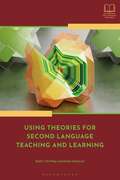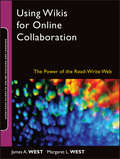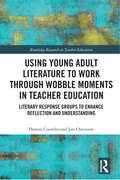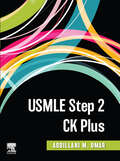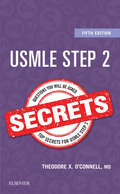- Table View
- List View
Using Theories for Second Language Teaching and Learning (Bloomsbury Guidebooks for Language Teachers)
by Dale T. Griffee Professor Greta GorsuchThis book helps second language teachers use theories in their practice, exploring in concrete and practical ways the intersections between teachers, learners, and institutions, and theories of teaching, theories of learning, and theories of language. These intersections provide language teachers with critical insights on how to deal with professional complexities and practical guidance on how to develop appropriate pedagogical practice. By focusing on theories of teaching, the authors give readers the tools to create a clear image of the kind of teacher they wish to be. By exploring theories of learning, they promote the formation of teachers' personal theories which allow them to identify their own areas of special interest in learner achievement and enrichment. By examining theories of language, the book shows how administrators and teachers can use theories to identify course goals and plan priorities for class time. Using Theories for Second Language Teaching and Learning treats theory as a concept in its own right and promotes knowing theory as a means of teacher discovery, reflection, and learning through case studies, which are descriptions and analyses of teachers thinking and acting in classrooms and in the institutions in which they work. Every chapter presents case studies with examples from the teaching of different languages, including Chinese, English, French, German, and Korean. An array of theories from multiple disciplines are featured and reflective projects are offered that lead readers to discover the importance and role of theory in daily professional life.
Using Thinking Skills in the Primary Classroom (PDF)
by Peter KellyThe good practice points add depth to the practical nature of this book and clearly set out its intention to provide reflection for teachers to extend their own skills and practice - Jan Baker, Head Teacher of Orchard Vale Community School
Using Thinking Skills in the Primary Classroom (PDF)
by Peter Kelly`The good practice points add depth to the practical nature of this book and clearly set out its intention to provide reflection for teachers to extend their own skills and practice' - Jan Baker, Head Teacher of Orchard Vale Community School 'Thoughtfully written and certainly of value to trainee teachers and those already teaching in school' - National Association for Gifted Children Newsletter Most children already display a range of thinking skills when they communicate with each another and when they talk about their interests (whether those are soap operas or car engines), and this book presents an approach for classroom practice that will encourage teachers to build on the often quite sophisticated thinking skills the children in their class already have. The author highlights points for good pratice, suggests some lesson ideas and builds in opportunities for professional reflection. Advice on the following is included: } classroom organization } approaches to collaborative groupwork } developing children's (and teachers') speaking and listening skills } building on the thinking skills that children of all abilities display } using questioning techniques to promote thinking skills in the classroom } whole-school issues. Each chapter ends with a summary of key points and there is some photocopiable material included. All teachers, teaching assistants and those co-ordinating the learning of gifted and talented pupils will find this book thought-provoking, stimulating and inspiring.
Using Video Games to Level Up Collaboration for Students: A Fun, Practical Way to Support Social-emotional Skills Development
by Matthew HarrisonUsing Video Games to Level Up Collaboration for Students provides a research-informed, systematic approach for using cooperative multiplayer video games as tools for teaching collaborative social skills and building social connections. Video games have become an ingrained part of our culture, and many teachers, school leaders and allied health professionals are exploring ways to harness digital games–based learning in their schools and settings. At the same time, collaborative skills and social inclusion have never been more important for our children and young adults. Taking a practical approach to supporting a range of learners, this book provides a three-stage system that guides professionals with all levels of gaming experience through skill instruction, supported play and guided reflection. A range of scaffolds and resources support the implementation of this program in primary and secondary classrooms and private clinics. Complementing this intervention design are a set of principles of game design that assist in the selection of games for use with this program, which assists with the selection of existing games or the design of future games for use with this program. Whether you are a novice or an experienced gamer, Level Up Collaboration provides educators with an innovative approach to ensuring that children and young adults can develop the collaborative social skills essential for thriving in their communities. By using an area of interest and strength for many individuals experiencing challenges with developing friendships and collaborative social skills, this intervention program will help your school or setting to level up social outcomes for all participants.
Using Video Games to Level Up Collaboration for Students: A Fun, Practical Way to Support Social-emotional Skills Development
by Matthew HarrisonUsing Video Games to Level Up Collaboration for Students provides a research-informed, systematic approach for using cooperative multiplayer video games as tools for teaching collaborative social skills and building social connections. Video games have become an ingrained part of our culture, and many teachers, school leaders and allied health professionals are exploring ways to harness digital games–based learning in their schools and settings. At the same time, collaborative skills and social inclusion have never been more important for our children and young adults. Taking a practical approach to supporting a range of learners, this book provides a three-stage system that guides professionals with all levels of gaming experience through skill instruction, supported play and guided reflection. A range of scaffolds and resources support the implementation of this program in primary and secondary classrooms and private clinics. Complementing this intervention design are a set of principles of game design that assist in the selection of games for use with this program, which assists with the selection of existing games or the design of future games for use with this program. Whether you are a novice or an experienced gamer, Level Up Collaboration provides educators with an innovative approach to ensuring that children and young adults can develop the collaborative social skills essential for thriving in their communities. By using an area of interest and strength for many individuals experiencing challenges with developing friendships and collaborative social skills, this intervention program will help your school or setting to level up social outcomes for all participants.
Using Video to Develop Teaching
by Niels BrouwerThe introduction of digital technology to video use has opened up new opportunities for raising the quality of teaching and learning. This book provides the first integrated account of how digital video can be used to develop teaching competence. It shows not only how using video can help teachers move towards more dialogic forms of teaching and learning, but also how such change benefits pupils’ learning and behaviour. Based on extensive literature reviews this book provides an overview of "visual teacher learning" and summarises what is known about instructional improvements that teachers can achieve by engaging in it. These reviews and the author’s empirical studies explain the activities, processes and organisational conditions needed for implementing visual teacher learning in teacher education and professional development. The book concludes with practical resources for practitioners incorporating the lessons drawn from theory and research.
Using Video to Develop Teaching
by Niels BrouwerThe introduction of digital technology to video use has opened up new opportunities for raising the quality of teaching and learning. This book provides the first integrated account of how digital video can be used to develop teaching competence. It shows not only how using video can help teachers move towards more dialogic forms of teaching and learning, but also how such change benefits pupils’ learning and behaviour. Based on extensive literature reviews this book provides an overview of "visual teacher learning" and summarises what is known about instructional improvements that teachers can achieve by engaging in it. These reviews and the author’s empirical studies explain the activities, processes and organisational conditions needed for implementing visual teacher learning in teacher education and professional development. The book concludes with practical resources for practitioners incorporating the lessons drawn from theory and research.
Using Video to Foster Teacher Development: Improving Professional Practice through Adaptation and Reflection
by Marte Blikstad-Balas Inga Staal JensetFeaturing an international team of education researchers and practitioners, this edited volume demonstrates various ways in which the use of video recordings can shed light on and improve teaching processes in the classroom environment.Providing a novel and global approach to this burgeoning area of research, chapters highlight how authentic video clips can be used systematically in both teacher education and professional development programs to ensure lifelong professional reflection and growth for teachers. Through detailed insight into research projects where teachers and teacher educators use video to improve practice, the book provides a research-based response to why and how videos can be used to raise instructional quality and discuss key issues in the field.Exploring findings from empirically based research combined with everyday practices, the volume will ultimately serve as a solid and inspiring introduction to the growing body of research on the use of video in teacher learning for educational researchers and educators interested in teaching and teaching practices, as well as practitioners in the fields of teacher education and teachers’ professional development.
Using Video to Foster Teacher Development: Improving Professional Practice through Adaptation and Reflection
Featuring an international team of education researchers and practitioners, this edited volume demonstrates various ways in which the use of video recordings can shed light on and improve teaching processes in the classroom environment.Providing a novel and global approach to this burgeoning area of research, chapters highlight how authentic video clips can be used systematically in both teacher education and professional development programs to ensure lifelong professional reflection and growth for teachers. Through detailed insight into research projects where teachers and teacher educators use video to improve practice, the book provides a research-based response to why and how videos can be used to raise instructional quality and discuss key issues in the field.Exploring findings from empirically based research combined with everyday practices, the volume will ultimately serve as a solid and inspiring introduction to the growing body of research on the use of video in teacher learning for educational researchers and educators interested in teaching and teaching practices, as well as practitioners in the fields of teacher education and teachers’ professional development.
Using Virtual Worlds in Educational Settings: Making Learning Real
by Lisa JackaThe building of communities outside of the traditional brick-and-mortar base of a school or university is at a significant point in time; virtual worlds bridge the gap between 2D web spaces online and 3D physical spaces of the classroom, providing teachers and students alike with opportunities to connect and collaborate in ways that were previously unimaginable. Providing insight into this new age of teaching, Using Virtual Worlds in Educational Settings presents a collection of practical, evidence-based ideas that illustrate the capacity for immersive virtual worlds to be integrated successfully in higher education and school settings. Examining research and stories from more than 1,000 students and six faculty members who introduced virtual worlds into their teaching and learning, this book contains practical examples of how virtual worlds can be introduced and supported, as well as reflections from faculty and students about their response to virtual worlds. This research will help teachers understand how to approach such a fundamental shift in pedagogy, how to liberate themselves from teacher-focused instruction and how to help students to develop their skills through collaboration. Outlining how and why virtual worlds could be the shift in pedagogy that teachers have been waiting for, Using Virtual Worlds in Educational Settings is an accessible, practical resource for educators to support their use of virtual worlds in teaching.
Using Virtual Worlds in Educational Settings: Making Learning Real
by Lisa JackaThe building of communities outside of the traditional brick-and-mortar base of a school or university is at a significant point in time; virtual worlds bridge the gap between 2D web spaces online and 3D physical spaces of the classroom, providing teachers and students alike with opportunities to connect and collaborate in ways that were previously unimaginable. Providing insight into this new age of teaching, Using Virtual Worlds in Educational Settings presents a collection of practical, evidence-based ideas that illustrate the capacity for immersive virtual worlds to be integrated successfully in higher education and school settings. Examining research and stories from more than 1,000 students and six faculty members who introduced virtual worlds into their teaching and learning, this book contains practical examples of how virtual worlds can be introduced and supported, as well as reflections from faculty and students about their response to virtual worlds. This research will help teachers understand how to approach such a fundamental shift in pedagogy, how to liberate themselves from teacher-focused instruction and how to help students to develop their skills through collaboration. Outlining how and why virtual worlds could be the shift in pedagogy that teachers have been waiting for, Using Virtual Worlds in Educational Settings is an accessible, practical resource for educators to support their use of virtual worlds in teaching.
Using Visual Technology in Educational Ethnography: Theory, Method and the Visual (Qualitative and Visual Methodologies in Educational Research)
by Rita Chawla-DugganIntroducing readers to debates underpinning the uses of visual technology in educational ethnography, this book takes actual research projects across different country contexts to discuss how research designs can use visual technology in educational ethnography; to show connections between theory, method and research problems.The book begins by introducing readers to three epistemological positions underpinning the use of visual technology in social science and educational research: the scientific realist, reflexive, and dialectic. It illustrates the uses of visual technology in the form of digital film and photographs, and how as a source of data, it has potential in developing ethnographic knowledge and representation in a range of educational contexts. The ideas are illustrated through three research projects in the context of classrooms, home environments and intervention work with practitioners. With clear practical applications, this resource considers the part theory plays in research designs, which use visual technology to investigate educational problems.Using Visual Technology in Educational Ethnography is ideal reading for anyone seeking to learn more about the benefits and practicalities of using visual technology within their ethnographic practice.
Using Visual Technology in Educational Ethnography: Theory, Method and the Visual (Qualitative and Visual Methodologies in Educational Research)
by Rita Chawla-DugganIntroducing readers to debates underpinning the uses of visual technology in educational ethnography, this book takes actual research projects across different country contexts to discuss how research designs can use visual technology in educational ethnography; to show connections between theory, method and research problems.The book begins by introducing readers to three epistemological positions underpinning the use of visual technology in social science and educational research: the scientific realist, reflexive, and dialectic. It illustrates the uses of visual technology in the form of digital film and photographs, and how as a source of data, it has potential in developing ethnographic knowledge and representation in a range of educational contexts. The ideas are illustrated through three research projects in the context of classrooms, home environments and intervention work with practitioners. With clear practical applications, this resource considers the part theory plays in research designs, which use visual technology to investigate educational problems.Using Visual Technology in Educational Ethnography is ideal reading for anyone seeking to learn more about the benefits and practicalities of using visual technology within their ethnographic practice.
Using Wikis for Online Collaboration: The Power of the Read-Write Web (Jossey-Bass Guides to Online Teaching and Learning #15)
by James A. West Margaret L. WestHow can online instructors and course designers' instruction harness the popular Web 2.0 tool, the wiki, for successful collaboration and learning outcomes? This book focuses on using wikis in the active learning processes that are the hallmark of collaborative learning and constructivism. It provides both the pedagogical background and practical guidelines, tools, and processes for accomplishing these goals with special emphasis on wikis and other collaborative design tools. This book supports the effective design and delivery of online courses through the integration of collaborative writing and design activities.
Using Wikis for Online Collaboration: The Power of the Read-Write Web (Jossey-Bass Guides to Online Teaching and Learning #10)
by James A. West Margaret L. WestHow can online instructors and course designers' instruction harness the popular Web 2.0 tool, the wiki, for successful collaboration and learning outcomes? This book focuses on using wikis in the active learning processes that are the hallmark of collaborative learning and constructivism. It provides both the pedagogical background and practical guidelines, tools, and processes for accomplishing these goals with special emphasis on wikis and other collaborative design tools. This book supports the effective design and delivery of online courses through the integration of collaborative writing and design activities.
Using Young Adult Literature to Work through Wobble Moments in Teacher Education: Literary Response Groups to Enhance Reflection and Understanding (Routledge Research in Teacher Education)
by Dawan Coombs Jon OstensonThis volume offers a novel approach to exploring how literary response groups can be used as part of teacher education programs to help preservice teachers navigate "wobble" moments. Focusing uniquely on the potential of young adult literature (YAL), the text draws on the first-hand experiences of teacher candidates and uses a range of well-known books to demonstrate how narrative-based inquiry and analysis of fictional depictions of teaching and learning can support reflection on a range of common challenges. The volume presents how YAL literary response groups are shown to enhance participants’ ability to reflect on practice, build resilience, and develop deeper understanding of pedagogical principles by offering a shared dialogical space. These insights ultimately contribute to teacher education program improvement by enhancing teacher candidates’ understanding of pedagogy. This text will benefit researchers, doctoral students, and academics in the fields of teaching, teacher mentoring, and teacher education more specifically. Those interested in literature studies and young adult literature (YAL) more broadly will also benefit from this volume.
Using Young Adult Literature to Work through Wobble Moments in Teacher Education: Literary Response Groups to Enhance Reflection and Understanding (Routledge Research in Teacher Education)
by Dawan Coombs Jon OstensonThis volume offers a novel approach to exploring how literary response groups can be used as part of teacher education programs to help preservice teachers navigate "wobble" moments. Focusing uniquely on the potential of young adult literature (YAL), the text draws on the first-hand experiences of teacher candidates and uses a range of well-known books to demonstrate how narrative-based inquiry and analysis of fictional depictions of teaching and learning can support reflection on a range of common challenges. The volume presents how YAL literary response groups are shown to enhance participants’ ability to reflect on practice, build resilience, and develop deeper understanding of pedagogical principles by offering a shared dialogical space. These insights ultimately contribute to teacher education program improvement by enhancing teacher candidates’ understanding of pedagogy. This text will benefit researchers, doctoral students, and academics in the fields of teaching, teacher mentoring, and teacher education more specifically. Those interested in literature studies and young adult literature (YAL) more broadly will also benefit from this volume.
Using Your Voice Effectively in the Classroom
by Jonathan Savage William EvansAs a teacher, you are required to use your voice more than any other professional! Your voice is the most important tool that you have at your disposal to inspire students and help them learn effectively. Using your voice powerfully and effectively is the key to becoming an outstanding teacher. Developing a strong vocal presence in the classroom influences everything else that you do, helping to build your confidence and positive interactions with students. If you neglect your voice as a teacher, you are more likely to end up stressed, have a shorter teaching career and suffer from vocal health issues. This book explores how you can learn to use your voice effectively in the classroom, linking together basic theory about vocal production and teacher identity with numerous practical tips, tricks and exercises which you can apply to your own teaching. Covering all aspects of the voice and its employment both inside the classroom and its importance to daily life outside, the book tackles topics such as: the philosophy of the voice, how it develops and its role in creating your own identity the mechanical and mental skills required to develop a teaching voice acquiring confidence and an exploration of body language to underpin your vocal production the relationship between the student’s voice and the teacher’s voice the importance of practice for a teacher the practicality of caring for one’s voice. Using Your Voice Effectively in the Classroom offers a much-needed exploration and thorough examination of the voice in the classroom and will be an indispensable guide for trainee teachers, as well as valuable reading for all practising teachers.
Using Your Voice Effectively in the Classroom
by Jonathan Savage William EvansAs a teacher, you are required to use your voice more than any other professional! Your voice is the most important tool that you have at your disposal to inspire students and help them learn effectively. Using your voice powerfully and effectively is the key to becoming an outstanding teacher. Developing a strong vocal presence in the classroom influences everything else that you do, helping to build your confidence and positive interactions with students. If you neglect your voice as a teacher, you are more likely to end up stressed, have a shorter teaching career and suffer from vocal health issues. This book explores how you can learn to use your voice effectively in the classroom, linking together basic theory about vocal production and teacher identity with numerous practical tips, tricks and exercises which you can apply to your own teaching. Covering all aspects of the voice and its employment both inside the classroom and its importance to daily life outside, the book tackles topics such as: the philosophy of the voice, how it develops and its role in creating your own identity the mechanical and mental skills required to develop a teaching voice acquiring confidence and an exploration of body language to underpin your vocal production the relationship between the student’s voice and the teacher’s voice the importance of practice for a teacher the practicality of caring for one’s voice. Using Your Voice Effectively in the Classroom offers a much-needed exploration and thorough examination of the voice in the classroom and will be an indispensable guide for trainee teachers, as well as valuable reading for all practising teachers.
USMLE Images for the Boards E-Book: A Comprehensive Image-Based Review
by Amber S. Tully James S. StuddifordStay on top of USMLE steps 1,2,3 preparation with USMLE Images for the Boards: A Comprehensive Image-Based Review, the first comprehensive image-based review aid available! This high-yield medical textbook will help you identify and interpret the images you’re likely to see on the exam, allowing you to approach the boards with confidence and land the best score.Optimize your visual diagnostic skills with the only review tool that focuses on image interpretation in a standardized-testing environment and provides evidence-based data governing the selection of imaging modalities for a particular disease. Prepare for all steps of the USMLE with 300 full-color medical images, including: EKGs, plain film/CT/MRI radiology, pathology slides, gross tissue specimens, and images depicting commonly tested diseases encountered within the fields of ophthalmology, urology, internal medicine, OB/GYN, pediatrics, orthopedics, and ENT. Retain all the necessary information and evaluate your understanding thanks to an easy-to-follow format and challenging board-style review questions with high-yield explanations.
USMLE Step 1 Secrets E-Book (Secrets)
by Thomas A. Brown Sonali J BrackenUse the proven format of the best-selling Secrets SeriesTM to prepare for the USMLE Step 1. Presented as questions and answers based on clinical vignettes, USMLE Step 1 Secrets will aid you in not only retaining but understanding key information for the boards. Co-authored by Dr.Tom Brown, author of Rapid Review in Physiology, and Dr.Dave Brown, the second edition has been updated to be even more concise and ultra high-yield, while still offering a complete overview of the key topics and the top “secrets" and personal insights from the authors.Utilizes a case-based approach to prepare you for the Step 1 exam. Implements systems-based organization for an integrated approach. Uses the Secrets Q&A format to make learning interesting and effective.Uses a new Top 100 Secrets chapter as a recap of the most important information in the book to help you review quickly.Incorporates 7 new chapters, including Clinical Anatomy and Pharmacology, and Toxicology to expand coverage of high-yield areas and keep you current.Provides maximum information in minimal time to help fit a concise review into your busy schedule.Includes a color pathology and dermatology section to enhance the clarity and understanding of key images.
USMLE Step 1 Secrets in Color E-Book (Secrets)
by Thomas A. Brown Sonali J BrackenConcise and easy-to-use, USMLE Step 1 Secrets provides the most effective, high-yield review you need for achieving success on this high-stakes exam. Presented in the popular Secrets Q&A format, this bestselling USMLE review book features questions and short answers along with case scenarios to prepare you for the vignette-style USMLE exam.A case-based approach and abundant clinical context help prepare for the vignette-style of the USMLE exam. Renowned USMLE review author Dr. Thomas Brown and Dr. Sonali Bracken bring together their expertise with a team of medical student reviewers and authors to provide the most current overview of board-tested content. Figures, tables, and summary boxes provide a visual and concise overview of important board-relevant content. New color images added throughout—including those found in a new chapter covering high-yield dermatology and pathology—enhance visual review of important, board-relevant images.
USMLE Step 2 CK Plus EBOOK
by Abdillahi OmarHere’s your one-stop, comprehensive review source for the USMLE Step 2 Clinical Knowledge (CK), from an author who scored above the 99th percentile on this challenging exam. In one convenient place, USMLE Step 2 CK Plus covers the breadth and depth of material you need to know to not only pass, but excel on the Step 2 CK. “This book reflects what I would have wanted when I was studying for the USMLE Step 2 CK exam." — author Abdillahi Omar Offers comprehensive, high-yield coverage in a concise, outline format. Includes numerous tables, clinical photos, micrographs, and x-rays for a superb visual review and improved retention of the material. Provides the depth and breadth needed for effective study in an easy-to-use, logically organized, portable format—perfect for self-study or review anytime, anywhere.
USMLE Step 2 Secrets E-Book (Secrets)
by Theodore X. O'ConnellUSMLE Step 2 Secrets is an easy-to-read review perfect for busy students like you. Theodore X. O’Connell, MD ― author of several review and clinical reference books ― has thoroughly revised this popular text, which presents essential questions and answers covering the important concepts you need to know to score well on the USMLE Step 2 exam: key conditions you will be expected to recognize, all specialty and subspecialty topics, and necessary clinical concepts.Consult this title on your favorite e-reader, conduct rapid searches, and adjust font sizes for optimal readability. Compatible with Kindle®, nook®, and other popular devices. Learn the most important questions and answers with the proven format of the highly acclaimed Secrets Series®. Master all specialty and subspecialty topics covered on Step 2. Identify key facts in the "Top 100 Secrets." Consult the book wherever you go thanks to a portable size that fits in your lab coat pocket. Review material quickly and easily thanks to bulleted lists, algorithms, illustrations, and a new 4-color section featuring key pathologic and clinical images. Apply tips, memory aids, and "secrets" gathered by Theodore X. O’Connell, MD, and used trusted by students to pass the boards. Find information quickly with a second color highlighting chapter and section titles, legends, bullets and icons, and key terms. Benefit from thorough revisions that ensure high-yield focus and most current overview of board-tested content.
USMLE Step 2 Secrets E-Book: Usmle Step 2 Secrets (Secrets)
by Theodore X. O'ConnellConcise and easy to use, USMLE Step 2 Secrets, by prolific author Theodore X. O’Connell, MD, is an effective, high-yield review for achieving success on this high-stakes exam. Presented in the popular, time-tested Secrets® Q&A format, this bestselling USMLE review book prepares you for the broad-based diagnosis, treatment, and management questions you’ll face on the vignette-style USMLE exam.The proven Secrets® format gives you the most return for your time – concise, easy to read, engaging, and highly effective. Essential questions and answers cover the key conditions you will be expected to recognize, all specialty and subspecialty topics, and necessary clinical concepts. Top 100 Secrets, tips, and memory aids provide a fast overview of the secrets you must know for success in practice and on exams. Portable size makes it easy to carry with you for quick reference or review anywhere, anytime. Thoroughly updated to ensure that content reflects the current USMLE exam. New color images added throughout, plus numerous figures, tables, and summary boxes for visual overview of essential, board-relevant content.
